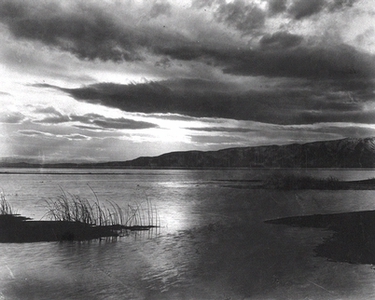RICH COUNTY

Bear Lake, Rich County
Area: 1,034 square miles;
Population: 1,725 (in 1990);
County seat: Randolph;
Origin of county name: two versions exist--(1) named for the fertility of the Bear River Valley (the county was first called Richland), (2) named for Charles C. Rich, a Mormon apostle, instrumental in the settlement of the Bear Lake area;
Principal cities/towns: Randolph (488), Laketown (261), Garden City (193);
Economy: agriculture, cattle, sheep, recreation;
Points of interest: Bear Lake State Park, Rendezvous Beach State Park, Randolph LDS Tabernacle.
Rich County, located in the upper northeastern corner of Utah, occupies a long, narrow area approximately eighteen miles wide and fifty-six miles long, extending north of Echo Canyon. It is bordered on the east by Wyoming, on the north by Idaho (with the southern half of Bear Lake extending into the county), on the west by several Utah counties and the Wasatch National Forest, and on the south by Summit County.
Fur trappers visited the Bear Lake Valley as early as 1811 when Joseph Miller reportedly discovered the Bear River. The area around the Bear River became a favorite spot for trappers, and the annual trappers' rendezvous was held on the south shore of Bear Lake in 1827 and in 1828. The Oregon Trail cut through a corner of the county. Dr. Marcus Whitman and his wife, Narcissa Prentiss Whitman, the famous Oregon pioneers, traveled on this trail in 1836. The first permanent white settler in the area was Thomas L. "Peg Leg" Smith, who operated a cattle business along with a trading post and horse exchange for Indians and Oregon Trail immigrants on the Bear River where Dingle, Idaho, is located today. Brigham Young unsuccessfully attempted to purchase his business in 1848, but Smith remained in the area until 1863 when he became discouraged and left.
When Congress passed the Homestead Act of 1862, Brigham Young became anxious to obtain control of the land before non-Mormons did. In August 1863 he called Charles C. Rich to lead an exploring party into the Bear Lake Valley to select a site for settlement. The first settlement, known as North Twin Creek and later as Paris Creek, was made near present Paris, Idaho. Since Bannock and Shoshoni Indians also used the valley, Rich obtained their permission to settle there in order to minimize conflicts. Other settlements were soon founded, including Round Valley in 1863, Kennedyville, (Garden City) and Laketown in 1864, Woodruff in 1865, Randolph in 1870, and Argyle in 1875.
Originally part of Green River County, which was formed in 1852, the county became Richland County in 1864. The name was shortened to Rich in 1868, and a final alteration occurred in 1872 when part of Cache County was added to the county by the territorial legislature.
Harsh winters affected the settlement of the Bear Lake Valley. Woodruff averages only fifty-seven frost-free days a year and holds the record for the coldest temperature ever recorded in the state ( minus 50°F on 6 February 1899). Even though much of Rich County is highland, it also has fertile lowlands that support productive farms and livestock, and three-fourths of the county's land is used for agriculture, primarily grazing. Livestock and livestock products account for the greater part of the county's income. The development of Bear Lake as a popular recreation area with resorts, public beaches, and summer homes has helped to diversify Rich County's economy.
Disclaimer: Information on this site was converted from a hard cover book published by University of Utah Press in 1994. Any errors should be directed towards the University of Utah Press.